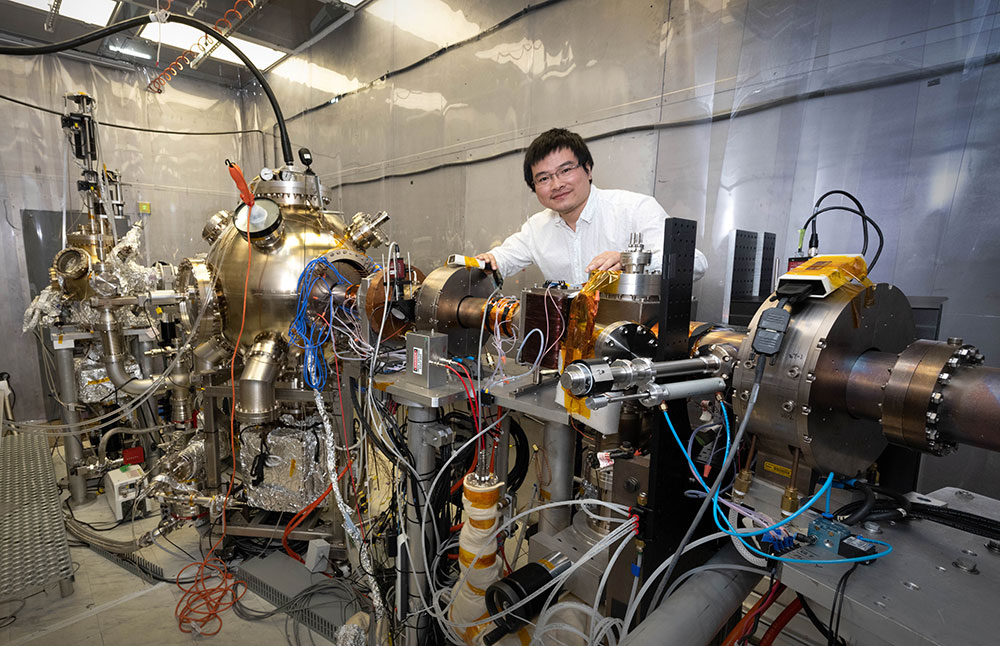530th Brookhaven Lecture: Photocathode Guns for Electron Beams
November 15, 2022
Particle accelerators propel protons, ions, electrons, and other particles to higher speeds and energy levels. Some accelerators produce medical isotopes to diagnose and fight diseases. Others are used for industrial processes such as manufacturing.
At the U.S. Department of Energy's Brookhaven National Laboratory, scientists have developed accelerator technologies for nuclear physics experiments at the Relativistic Heavy Ion Collider (RHIC). And their focus is shifting to technologies needed for the future Electron-Ion Collider (EIC). This future facility will help answer questions such as, "What is the origin of visible mass? What holds visible matter together and how? And what is the origin of the proton's 'spin' property?"
Scientists at RHIC, today, and the EIC, in the future, require high-quality electron beams with properties that are optimized for brightness, polarization, current, and intensity. Photocathode guns are the reliable—yet complex—electron sources they need.
On Wednesday, Nov. 16, join accelerator physicist Erdong Wang of the EIC organization at Brookhaven Lab for the 530th Brookhaven Lecture. His talk, titled "Photocathode Guns for Generating High-Quality Electron Beams" will be held at 4 p.m. on Zoom.
During his talk, Wang will introduce the two primary components in photocathode guns: photocathodes, which serve as the source materials for electrons, and the gun that accelerates them. He will discuss a photocathode developed for the Low Energy RHIC Electron Cooling project and a polarized high-voltage direct current gun developed for the EIC. He will also describe applications for photocathode guns beyond nuclear physics experiments.
About the Speaker
Wang is a physicist at Brookhaven Lab, manager for Strong Hadron Cooling for the EIC, and a lead scientist of the Electron Source Development Group in the Collider-Accelerator Department.
After one year as a visiting scholar at the High Energy Accelerator Research Organization—KEK in Japan—Wang arrived at Brookhaven Lab as a visiting student in 2009. He earned his Ph.D. in physics nuclear techniques and applications from Peking University in 2011 and joined Brookhaven Lab through the prestigious Goldhaber Distinguished Fellowships program in 2012. That same year, the IEEE Nuclear and Plasma Sciences Society presented him with a Particle Accelerator Science and Technology Thesis Award for outstanding contributions to the field.
At Brookhaven, Wang was named assistant physicist in 2015, associate physicist in 2017, and physicist in 2019.
In addition to his research, Wang is a referee for scientific journals including Applied Physics Letters, the Journal of Applied Physics, Physical Review Accelerators and Beams, Chemistry of Materials, and Nuclear Instruments and Methods in Physics Research. He also serves a reviewer for a number of DOE programs.
Brookhaven National Laboratory is supported by the Office of Science of the U.S. Department of Energy. The Office of Science is the single largest supporter of basic research in the physical sciences in the United States and is working to address some of the most pressing challenges of our time. For more information, visit science.energy.gov.
Follow @BrookhavenLab on Twitter or find us on Facebook.
2022-20948 | INT/EXT | Newsroom










